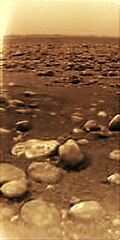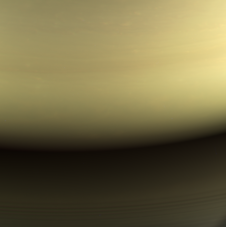Cassini–Huygens
 Artist's concept ofCassini'sorbit insertionaround Saturn | |
| Mission type | Cassini:Saturnorbiter Huygens:Titanlander |
|---|---|
| Operator | Cassini:NASA/JPL Huygens:ESA/ASI |
| COSPAR ID | 1997-061A |
| SATCATno. | 25008 |
| Website | |
| Mission duration |
|
| Spacecraft properties | |
| Manufacturer | Cassini:Jet Propulsion Laboratory Huygens:Thales Alenia Space(then Aerospatiale)[1] |
| Launch mass | 5,712 kg (12,593 lb)[2][3] |
| Dry mass | 2,523 kg (5,562 lb)[2] |
| Power | ~885 watts (BOL)[2] ~670 watts (2010)[4] ~663 watts (EOM/2017)[2] |
| Start of mission | |
| Launch date | October 15, 1997, 08:43:00UTC |
| Rocket | Titan IV(401)B/Centaur-TB-33 |
| Launch site | Cape CanaveralSLC-40 |
| End of mission | |
| Disposal | Controlled entry into Saturn[5][6] |
| Last contact | September 15, 2017
|
| Orbital parameters | |
| Reference system | Kronocentric |
| Flyby ofVenus(Gravity assist) | |
| Closest approach | April 26, 1998 |
| Distance | 283 km (176 mi) |
| Flyby ofVenus(Gravity assist) | |
| Closest approach | June 24, 1999 |
| Distance | 623 km (387 mi) |
| Flyby ofEarth-Moonsystem(Gravity assist) | |
| Closest approach | August 18, 1999, 03:28 UTC |
| Distance | 1,171 km (728 mi) |
| Flyby of2685 Masursky(Incidental) | |
| Closest approach | January 23, 2000 |
| Distance | 1,600,000 km (990,000 mi) |
| Flyby ofJupiter(Gravity assist) | |
| Closest approach | December 30, 2000 |
| Distance | 9,852,924 km (6,122,323 mi) |
| Saturnorbiter | |
| Orbital insertion | July 1, 2004, 02:48 UTC |
| Titanlander | |
| Spacecraft component | Huygens |
| Landing date | January 14, 2005 |
Cassini–Huygens(⫽kəˈsiːniˈhɔɪɡənz⫽kə-SEE-neeHOY-gənz), commonly calledCassini,was aspace-researchmission byNASA,theEuropean Space Agency(ESA), and theItalian Space Agency(ASI) to send aspace probeto study theplanetSaturnand its system, including itsringsandnatural satellites.TheFlagship-classrobotic spacecraftcomprised both NASA'sCassinispace probe and ESA'sHuygenslander,which landed on Saturn's largest moon,Titan.[8]Cassiniwas the fourth space probe to visit Saturn and the first to enter its orbit, where it stayed from 2004 to 2017. The two craft took their names from the astronomersGiovanni CassiniandChristiaan Huygens.
Launched aboard aTitan IVB/Centauron October 15, 1997,Cassiniwas active in space for nearly 20 years, with 13 years spent orbiting Saturn and studying the planet and its system afterentering orbiton July 1, 2004.[9]
The voyage to Saturn includedflybysofVenus(April 1998 and July 1999),Earth(August 1999), the asteroid2685 Masursky,andJupiter(December 2000). The mission ended on September 15, 2017, whenCassini's trajectory took it into Saturn's upper atmosphere and it burned up[10][11]in order to prevent any risk of contaminating Saturn's moons, which might have offered habitable environments to stowaway terrestrial microbes on the spacecraft.[12][13]The mission was successful beyond expectations – NASA's Planetary Science Division Director,Jim Green,describedCassini-Huygensas a "mission of firsts"[14]that has revolutionized human understanding of the Saturn system, including its moons and rings, and our understanding of where life might be found in theSolar System.[15]
Cassini's planners originally scheduled a mission of four years, from June 2004 to May 2008. The mission was extended for another two years until September 2010, branded theCassini Equinox Mission.The mission was extended a second and final time with theCassini Solstice Mission,lasting another seven years until September 15, 2017, on which dateCassiniwas de-orbited to burn up in Saturn's upper atmosphere.[16]
TheHuygensmodule traveled withCassiniuntil its separation from the probe on December 25, 2004; Huygens landed byparachuteon Titan on January 14, 2005. The separation was facilitated by the SED (Spin/Eject device), which provided a relative separation speed of 0.35 metres per second (1.1 ft/s) and a spin rate of 7.5 rpm.[17]It returned data to Earth for around 90 minutes, using the orbiter as a relay. This was the firstlandingever accomplished in the outer Solar System and the first landing on a moon other than Earth's Moon.
At the end of its mission, theCassinispacecraft executed its "Grand Finale": a number of risky passes through the gaps between Saturn and its inner rings.[5][6] This phase aimed to maximizeCassini'sscientific outcome before the spacecraft was intentionally destroyed[18]to prevent potential contamination of Saturn's moons ifCassiniwere to unintentionally crash into them when maneuvering the probe was no longer possible due to power loss or other communication issues at the end of its operational lifespan. Theatmospheric entryofCassiniended the mission, but analysis of the returned data will continue for many years.[15]
Overview[edit]
Scientists and individuals from 27 countries made up the joint team responsible for designing, building, flying and collecting data from theCassiniorbiter and theHuygensprobe.[19]
NASA'sJet Propulsion Laboratoryin the United States, where the orbiter was assembled, managed the mission. TheEuropean Space Research and Technology CentredevelopedHuygens.The centre's prime contractor,Aérospatialeof France (part ofThales Alenia Spacefrom 2005), assembled the probe with equipment and instruments supplied by many European countries (includingHuygens'batteries and two scientific instruments from the United States). TheItalian Space Agency(ASI) provided theCassiniorbiter'shigh-gain radio antenna,with the incorporation of a low-gain antenna (to ensure telecommunications with the Earth for the entire duration of the mission), a compact and lightweightradar,which also used the high-gain antenna and served as asynthetic-aperture radar,aradar altimeter,aradiometer,theradio science subsystem(RSS), and thevisible-channel portion VIMS-V of VIMSspectrometer.[20]
NASAprovided the VIMS infrared counterpart, as well as the Main Electronic Assembly, which included electronic sub-assemblies provided byCNESof France.[21][22]
On April 16, 2008, NASA announced a two-year extension of the funding for ground operations of this mission, at which point it was renamed the Cassini Equinox Mission.[23] The round of funding was again extended[by whom?]in February 2010 with theCassini Solstice Mission.
Naming[edit]
The mission consisted of two main elements: the ASI/NASACassiniorbiter, named for the Italian astronomerGiovanni Domenico Cassini,discoverer ofSaturn's ringdivisions and four of its satellites; and the ESA-developedHuygensprobe,named for the Dutch astronomer, mathematician and physicistChristiaan Huygens,discoverer of Titan.
The mission was commonly called Saturn Orbiter Titan Probe (SOTP) during gestation, both as aMariner Mark IImission and generically.[24]
Cassini-Huygenswas aFlagship-class missionto the outer planets.[8]The other planetary flagships includeGalileo,Voyager,andViking.[8]
Objectives[edit]
Cassinihad several objectives, including:[25]
- Determining the three-dimensional structure and dynamic behavior of therings of Saturn.
- Determining the composition of thesatellitesurfaces and the geological history of each object.
- Determining the nature and origin of the dark material onIapetus's leading hemisphere.
- Measuring the three-dimensional structure and dynamic behavior of themagnetosphere.
- Studying the dynamic behavior of Saturn'satmosphereat cloud level.
- Studying the time variability of Titan's clouds andhazes.
- Characterizing Titan's surface on a regional scale.
Cassini–Huygenswas launched on October 15, 1997, fromCape Canaveral Air Force Station'sSpace Launch Complex 40using aU.S. Air ForceTitan IVB/Centaurrocket. The complete launcher was made up of a two-stageTitan IVbooster rocket,two strap-on solidrocket engines,the Centaur upper stage, and a payload enclosure, or fairing.[26]
The total cost of this scientific exploration mission was about US$3.26billion,including $1.4 billion for pre-launch development, $704millionfor mission operations, $54 million for tracking and $422 million for the launch vehicle. The United States contributed $2.6 billion (80%), the ESA $500 million (15%), and the ASI $160 million (5%).[27]However, these figures are from the press kit which was prepared in October 2000. They do not include inflation over the course of a very long mission, nor do they include the cost of the extended missions.
The primary mission forCassiniwas completed on July 30, 2008. The mission was extended to June 2010 (CassiniEquinox Mission).[28]This studied the Saturn system in detail during the planet'sequinox,which happened in August 2009.[23]
On February 3, 2010, NASA announced another extension forCassini,lasting 61⁄2years until 2017, ending at the time of summer solstice in Saturn's northern hemisphere (CassiniSolstice Mission). The extension enabled another 155 revolutions around the planet, 54 flybys of Titan and 11 flybys ofEnceladus.[29] In 2017, an encounter with Titan changed its orbit in such a way that, at closest approach to Saturn, it was only 3,000 km (1,900 mi) above the planet's cloudtops, below the inner edge of theD ring.This sequence of "proximal orbits" ended when its final encounter with Titan sent the probe into Saturn's atmosphere to be destroyed.
Itinerary[edit]
| Selected destinations (ordered largest to smallest but not to scale) | ||||||
|---|---|---|---|---|---|---|
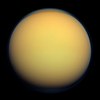 |
 |
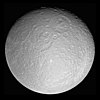 |
 |
 |
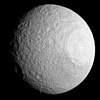 |
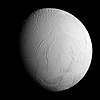 |
| Titan | Earth'sMoon | Rhea | Iapetus | Dione | Tethys | Enceladus |
 |
 |
 |
 |
 |
 |
 |
| Mimas | Hyperion | Phoebe | Janus | Epimetheus | Prometheus | Pandora |
 |
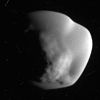 |
 |
 |
 |
 | |
| Helene | Atlas | Pan | Telesto | Calypso | Methone | |
History[edit]


Cassini–Huygens's origins date to 1982, when theEuropean Science Foundationand the AmericanNational Academy of Sciencesformed aworking groupto investigate future cooperative missions. Two European scientists suggested a paired Saturn Orbiter and Titan Probe as a possible joint mission. In 1983, NASA'sSolar System Exploration Committeerecommended the same Orbiter and Probe pair as a core NASA project. NASA and theEuropean Space Agency(ESA) performed a joint study of the potential mission from 1984 to 1985. ESA continued with its own study in 1986, while the American astronautSally Ride,in her influential 1987 reportNASA Leadership and America's Future in Space,also examined and approved of theCassinimission.[30]
While Ride's report described the Saturn orbiter and probe as a NASA solo mission, in 1988 the Associate Administrator for Space Science and Applications of NASA, Len Fisk, returned to the idea of a joint NASA and ESA mission. He wrote to his counterpart at ESA, Roger Bonnet, strongly suggesting that ESA choose theCassinimission from the three candidates at hand and promising that NASA would commit to the mission as soon as ESA did.[31]
At the time, NASA was becoming more sensitive to the strain that had developed between the American and European space programs as a result of European perceptions that NASA had not treated it like an equal during previous collaborations. NASA officials and advisers involved in promoting and planningCassini–Huygensattempted to correct this trend by stressing their desire to evenly share any scientific and technology benefits resulting from the mission. In part, this newfound spirit of cooperation with Europe was driven by a sense of competition with theSoviet Union,which had begun to cooperate more closely with Europe as ESA drew further away from NASA. Late in 1988, ESA chose Cassini–Huygens as its next major mission and the following year the program received major funding in the US.[32][33]
The collaboration not only improved relations between the two space programs but also helpedCassini–Huygenssurvive congressional budget cuts in the United States.Cassini–Huygenscame under fire politically in both 1992 and 1994, but NASA successfully persuaded theUnited States Congressthat it would be unwise to halt the project after ESA had already poured funds into development because frustration on broken space exploration promises might spill over into other areas of foreign relations. The project proceeded politically smoothly after 1994, although citizens' groups concerned about the potential environmental impact a launch failure might have (because of its plutonium power source) attempted to derail it through protests and lawsuits until and past its 1997 launch.[34][35][36][37][38]
Spacecraft design[edit]
The spacecraft was planned to be the second three-axis stabilized,RTG-poweredMariner Mark II,a class of spacecraft developed for missions beyond the orbit ofMars,after theComet Rendezvous Asteroid Flyby(CRAF) mission, but budget cuts and project rescopings forced NASA to terminate CRAF development to saveCassini.As a result,Cassinibecame more specialized. The Mariner Mark II series was cancelled.
The combined orbiter and probe is the third-largest uncrewedinterplanetaryspacecraft ever successfully launched, behind thePhobos 1and2Mars probes, as well as being among the most complex.[39][40]The orbiter had a mass of 2,150 kg (4,740 lb), the probe 350 kg (770 lb) including 30 kg (66 lb) of probe support equipment left on the orbiter. With the launch vehicle adapter and 3,132 kg (6,905 lb) of propellants at launch, the spacecraft had a mass of 5,600 kg (12,300 lb).
TheCassinispacecraft was 6.8 meters (22 ft) high and 4 meters (13 ft) wide. Spacecraft complexity was increased by itstrajectory(flight path) to Saturn, and by the ambitious science at its destination.Cassinihad 1,630 interconnectedelectronic components,22,000 wire connections, and 14 kilometers (8.7 mi) of cabling.[41]The core control computer CPU was a redundant system using theMIL-STD-1750Ainstruction set architecture.The main propulsion system consisted of one prime and one backupR-4Dbipropellant rocket engine. The thrust of each engine was 490N(110lbf) and the total spacecraftdelta-vwas 2,352 m/s (5,260 mph).[42]Smaller monopropellant rockets provided attitude control.
Cassiniwas powered by 32.7 kg (72 lb) of nuclear fuel, mainlyplutonium dioxide(containing 28.3 kg (62 lb) of pureplutonium).[43]The heat from the material's radioactive decay was turned into electricity.Huygenswas supported byCassiniduring cruise, but used chemical batteries when independent.
The probe contained a DVD with more than 616,400 signatures from citizens in 81 countries, collected in a public campaign.[44][45]
Until September 2017 theCassiniprobe continued orbiting Saturn at a distance of between 8.2 and 10.2astronomical units(1.23×109and 1.53×109km;760,000,000 and 950,000,000mi) from the Earth. It took 68 to 84 minutes for radio signals totravelfrom Earth to the spacecraft, and vice versa. Thus ground controllers could not give "real-time" instructions for daily operations or for unexpected events. Even if response were immediate, more than two hours would have passed between the occurrence of a problem and the reception of the engineers' response by the satellite.
Instruments[edit]

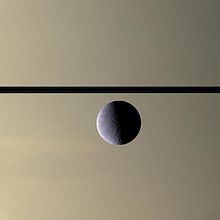
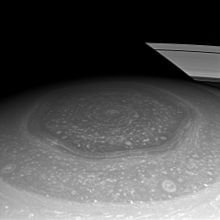


Summary[edit]
Instruments:[47]
- OpticalRemote Sensing( "Located on the remote sensing pallet" )[47]
- Composite Infrared Spectrometer (CIRS)
- Imaging Science Subsystem (ISS)
- Ultraviolet Imaging Spectrograph (UVIS)
- Visible and Infrared Mapping Spectrometer (VIMS)
- Fields, Particles and Waves (mostlyin situ)
- Cassini Plasma Spectrometer (CAPS)
- Cosmic Dust Analyzer (CDA)
- Ion and Neutral Mass Spectrometer (INMS)
- Magnetometer (MAG)
- Magnetospheric Imaging Instrument (MIMI)
- Radio and Plasma Wave Science (RPWS)
- Microwave Remote Sensing
- Radar
- Radio Science (RSS)
Description[edit]
Cassini's instrumentation consisted of: asynthetic aperture radarmapper, acharge-coupled deviceimaging system, a visible/infraredmappingspectrometer,a composite infrared spectrometer, acosmic dustanalyzer, a radio andplasmawave experiment, a plasma spectrometer, anultravioletimaging spectrograph, amagnetosphericimaging instrument, amagnetometerand anion/neutralmass spectrometer.Telemetryfrom the communicationsantennaand other special transmitters (anS-bandtransmitter and a dual-frequencyKa-bandsystem) was also used to make observations of the atmospheres of Titan and Saturn and to measure thegravityfields of the planet and its satellites.
- Cassini Plasma Spectrometer (CAPS)
- CAPS was an in situ instrument that measured the flux of charged particles at the location of the spacecraft, as a function of direction and energy. The ion composition was also measured using atime-of-flight mass spectrometer.CAPS measured particles produced by ionisation of molecules originating from Saturn's and Titan's ionosphere, as well as the plumes of Enceladus. CAPS also investigatedplasmain these areas, along with thesolar windand its interaction with Saturn's magnetosphere.[48][49]CAPS was turned off in June 2011, as a precaution due to a "soft" electricalshort circuitthat occurred in the instrument. It was powered on again in March 2012, but after 78 days another short circuit forced the instrument to be shut down permanently.[50]
- Cosmic Dust Analyzer(CDA)
- The CDA was an in situ instrument that measured the size, speed, and direction of tiny dust grains near Saturn. It could also measure the grains' chemical elements.[51]Some of these particles orbited Saturn, while others came from other star systems. The CDA on the orbiter was designed to learn more about these particles, the materials in other celestial bodies and potentially about the origins of the universe.[48]
- Composite Infrared Spectrometer (CIRS)
- The CIRS was a remote sensing instrument that measured theinfrared radiationcoming from objects to learn about their temperatures, thermal properties, and compositions. Throughout theCassini–Huygensmission, the CIRS measured infrared emissions from atmospheres, rings and surfaces in the vast Saturn system. It mapped the atmosphere of Saturn in three dimensions to determine temperature and pressure profiles with altitude, gas composition, and the distribution ofaerosolsand clouds. It also measured thermal characteristics and the composition of satellite surfaces and rings.[48]
- Ion and Neutral Mass Spectrometer (INMS)
- The INMS was an in situ instrument that measured the composition of charged particles (protons and heavier ions) and neutral particles (atoms and molecules) near Titan and Saturn to learn more about their atmospheres. The instrument used aquadrupole mass spectrometer.INMS was also intended to measure the positive ion and neutral environments of Saturn's icy satellites and rings.[48][52][53]
- Imaging Science Subsystem (ISS)
- The ISS was a remote sensing instrument that captured most images invisible light,and also some infrared images andultravioletimages. The ISS took hundreds of thousands of images of Saturn, its rings, and its moons. The ISS had both a wide-angle camera (WAC) and a narrow-angle camera (NAC). Each of these cameras used a sensitivecharge-coupled device(CCD) as itselectromagnetic wavedetector. Each CCD had a 1,024x1,024 square array of pixels, each pixel 12μmsquare. Both cameras allowed for many data collection modes, including on-chip data compression, and were fitted with spectral filters that rotated on a wheel to view different bands within the electromagnetic spectrum ranging from 0.2 to 1.1 μm.[48][54]
- Dual Technique Magnetometer(MAG)
- The MAG was an in situ instrument that measured the strength and direction of themagnetic field around Saturn.The magnetic fields are generated partly by the molten core at Saturn's center. Measuring the magnetic field is one of the ways to probe the core. MAG aimed to develop a three-dimensional model of Saturn's magnetosphere, and determine the magnetic state of Titan and its atmosphere, and the icy satellites and their role in the magnetosphere of Saturn.[48][55]
- Magnetospheric Imaging Instrument (MIMI)
- The MIMI was both an in situ and remote sensing instrument that produces images and other data about the particles trapped in Saturn's huge magnetic field, or magnetosphere. The in situ component measured energetic ions and electrons while the remote sensing component (the Ion And Neutral Camera, INCA) was anenergetic neutral atomimager.[56]This information was used to study the overall configuration and dynamics of the magnetosphere and its interactions with the solar wind, Saturn's atmosphere, Titan, rings, and icy satellites.[48][57]
- Radar
- The on-board radar was an active and passive sensing instrument that produced maps of Titan's surface. Radar waves were powerful enough to penetrate the thick veil of haze surrounding Titan. By measuring the send and return time of the signals it is possible to determine the height of large surface features, such as mountains and canyons. The passive radar listened for radio waves that Saturn or its moons may emit.[48]
- Radio and Plasma Wave Science instrument (RPWS)
- The RPWS was an in situ instrument and remote sensing instrument that receives and measures radio signals coming from Saturn, including the radio waves given off by the interaction of the solar wind with Saturn and Titan. RPWS measured the electric and magnetic wave fields in the interplanetary medium and planetary magnetospheres. It also determined the electron density and temperature near Titan and in some regions of Saturn's magnetosphere using either plasma waves at characteristic frequencies (e.g. theupper hybridline) or aLangmuir probe.RPWS studied the configuration of Saturn's magnetic field and its relationship to Saturn Kilometric Radiation (SKR), as well as monitoring and mapping Saturn's ionosphere, plasma, and lightning from Saturn's (and possibly Titan's) atmosphere.[48]
- Radio Science Subsystem(RSS)
- The RSS was a remote-sensing instrument that used radio antennas on Earth to observe the way radio signals from the spacecraft changed as they were sent through objects, such as Titan's atmosphere or Saturn's rings, or even behind theSun.The RSS also studied the compositions, pressures and temperatures of atmospheres and ionospheres, radial structure and particle size distribution within rings, body and system masses and thegravitational field.The instrument used the spacecraft X-band communication link as well as S-band downlink and Ka-band uplink and downlink.[48]

CassiniUVIS instrument built by the Laboratory for Atmospheric and Space Physics at the University of Colorado. - Ultraviolet Imaging Spectrograph (UVIS)
- The UVIS was a remote-sensing instrument that captured images of the ultraviolet light reflected off an object, such as the clouds of Saturn and/or its rings, to learn more about their structure and composition. Designed to measure ultraviolet light over wavelengths from 55.8 to 190 nm, this instrument was also a tool to help determine the composition, distribution, aerosol particle content and temperatures of their atmospheres. Unlike other types of spectrometer, this sensitive instrument could take both spectral and spatial readings. It was particularly adept at determining the composition of gases. Spatial observations took a wide-by-narrow view, only onepixeltall and 64 pixels across. The spectral dimension was 1,024 pixels per spatial pixel. It could also take many images that create movies of the ways in which this material is moved around by other forces.[48]
UVIS consisted of four separate detector channels, the Far Ultraviolet (FUV), Extreme Ultraviolet (EUV), High Speed Photometer (HSP) and the Hydrogen-Deuterium Absorption Cell (HDAC). UVIS collected hyperspectral imagery and discrete spectra of Saturn, its moons and its rings, as well as stellar occultation data.[58]
The HSP channel is designed to observe starlight that passes through Saturn's rings (known as stellar occultations) in order to understand the structure and optical depth of the rings.[59]Stellar occultation data from both the HSP and FUV channels confirmed the existence of water vapor plumes at the south pole of Enceladus, as well as characterized the composition of the plumes.[60]

VIMS spectra taken while looking throughTitan's atmospheretowards theSunhelped understand the atmospheres ofexoplanets(artist's concept; May 27, 2014). - Visible and Infrared Mapping Spectrometer (VIMS)
- The VIMS was a remote sensing instrument that captured images using visible and infrared light to learn more about the composition of moon surfaces, the rings, and the atmospheres of Saturn and Titan. It consisted of two cameras - one used to measure visible light, the other infrared. VIMS measured reflected and emitted radiation from atmospheres, rings and surfaces over wavelengths from 350 to 5100 nm, to help determine their compositions, temperatures and structures. It also observed the sunlight and starlight that passes through the rings to learn more about their structure. Scientists used VIMS for long-term studies of cloud movement and morphology in the Saturn system, to determine Saturn's weather patterns.[48]
Plutonium power source[edit]

Because of Saturn's distance from the Sun,solar arrayswere not feasible as power sources for this space probe.[61]To generate enough power, such arrays would have been too large and too heavy.[61]Instead, theCassiniorbiter was powered by threeGPHS-RTGradioisotope thermoelectric generators,which use heat from the decay of about 33 kg (73 lb) ofplutonium-238(in the form ofplutonium dioxide) to generate direct current electricity viathermoelectrics.[61] The RTGs on theCassinimission have the same design as those used on theNew Horizons,Galileo,andUlyssesspace probes, and they were designed to have very long operational lifetimes.[61] At the end of the nominal 11-yearCassinimission, they were still able to produce 600 to 700 watts of electrical power.[61](Leftover hardware from theCassiniRTG Program was modified and used to power theNew Horizonsmission toPlutoand theKuiper belt,which was designed and launched later.[62])
Power distributionwas accomplished by 192solid-statepower switches,which also functioned ascircuit breakersin the event of an overload condition. The switches usedMOSFETsthat featured better efficiency and a longer lifetime as compared to conventional switches, while at the same time eliminatingtransients.However, these solid-state circuit breakers were prone to erroneous tripping (presumably from cosmic rays), requiring them to reset and causing losses in experimental data.[63]

To gainmomentumwhile already in flight, the trajectory of theCassinimission included severalgravitational slingshotmaneuvers: two fly-by passes ofVenus,one more of the Earth, and then one of the planetJupiter.The terrestrial flyby was the final instance when the probe posed any conceivable danger to human beings. The maneuver was successful, withCassinipassing by 1,171 km (728 mi) above the Earth on August 18, 1999.[64] Had there been any malfunction causing the probe to collide with the Earth, NASA's complete environmental impact study estimated that, in the worst case (with an acute angle of entry in whichCassiniwould gradually burn up), a significant fraction of the 33 kg[43]of nuclear fuel inside the RTGs would have been dispersed into the Earth's atmosphere so that up to five billion people (i.e. almost the entire terrestrial population) could have been exposed, causing up to an estimated 5,000 additional cancer deaths over the subsequent decades[65](0.0005 per cent, i.e. a fraction 0.000005, of a billion cancer deaths expected anyway from other causes; the product is incorrectly calculated elsewhere[66]as 500,000 deaths). However, the chance of this happening were estimated to be less than one in one million, i.e. a chance of one person dying (assuming 5,000 deaths) as less than 1 in 200.[65]
NASA's risk analysis to use plutonium was publicly criticized byMichio Kakuon the grounds that casualties, property damage, and lawsuits resulting from a possible accident, as well as the potential use of other energy sources, such as solar and fuel cells, were underestimated.[67]
Telemetry[edit]
TheCassinispacecraft was capable of transmitting in several different telemetry formats. The telemetry subsystem is perhaps the most important subsystem, because without it there could be no data return.
The telemetry was developed from the ground up, due to the spacecraft using a more modern set of computers than previous missions.[68]Therefore,Cassiniwas the first spacecraft to adoptmini-packetsto reduce the complexity of the Telemetry Dictionary, and the software development process led to the creation of a Telemetry Manager for the mission.
There were around 1088 channels (in 67 mini-packets) assembled in theCassiniTelemetry Dictionary. Out of these 67 lower complexity mini-packets, 6 mini-packets contained the subsystem covariance and Kalman gain elements (161 measurements), not used during normal mission operations. This left 947 measurements in 61 mini-packets.
A total of seven telemetry maps corresponding to 7 AACS telemetry modes were constructed. These modes are: (1) Record; (2) Nominal Cruise; (3) Medium Slow Cruise; (4) Slow Cruise; (5) Orbital Ops; (6) Av; (7) ATE (Attitude Estimator) Calibration. These 7 maps cover all spacecraft telemetry modes.
Huygensprobe[edit]
TheHuygensprobe, supplied by theEuropean Space Agency(ESA) and named after the 17th century Dutch astronomer who first discovered Titan,Christiaan Huygens,scrutinized the clouds, atmosphere, and surface of Saturn's moon Titan in its descent on January 15, 2005. It was designed to enter and brake in Titan's atmosphere and parachute a fully instrumented robotic laboratory down to the surface.[69]
The probe system consisted of the probe itself which descended to Titan, and the probe support equipment (PSE) which remained attached to the orbiting spacecraft. The PSE includes electronics that track the probe, recover the data gathered during its descent, and process and deliver the data to the orbiter that transmits it to Earth. The core control computer CPU was a redundantMIL-STD-1750Acontrol system.
The data were transmitted by a radio link betweenHuygensandCassiniprovided by Probe Data Relay Subsystem (PDRS). As the probe's mission could not be telecommanded from Earth because of the great distance, it was automatically managed by the Command Data Management Subsystem (CDMS). The PDRS and CDMS were provided by theItalian Space Agency(ASI).
AfterCassini'slaunch, it was discovered that data sent from theHuygensprobe toCassiniorbiter (and then re-transmitted to Earth) would be largely unreadable. The cause was that thebandwidthof signal processing electronics was too narrow and the anticipatedDoppler shiftbetween the lander and the mother craft would put the signals out of the system's range. Thus,Cassini'sreceiver would be unable to receive the data fromHuygensduring its descent to Titan.[18]
A work-around was found to recover the mission. The trajectory ofCassiniwas altered to reduce the line of sight velocity and therefore the doppler shift.[18][70]Cassini's subsequent trajectory was identical to the previously planned one, although the change replaced two orbits prior to theHuygensmission with three, shorter orbits.
Selected events and discoveries[edit]


Venus and Earth fly-bys and the cruise to Jupiter[edit]
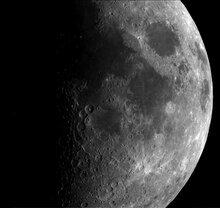
TheCassinispace probe performed twogravitational-assist flybysofVenuson April 26, 1998, and June 24, 1999. These flybys provided the space probe with enough momentum to travel all the way out to theasteroid belt,while the Sun's gravity pulled the space probe back into the inner Solar System.
On August 18, 1999, at 03:28 UTC, the craft made a gravitational-assist flyby of the Earth. One hour and 20 minutes before closest approach,Cassinimade its closest approach to the Earth's Moon at 377,000 kilometers, and it took a series of calibration photos.
On January 23, 2000,Cassiniperformed a flyby of theasteroid2685 Masurskyat around 10:00 UTC. It took photos[71]in the period five to seven hours before the flyby at a distance of 1.6×106km (0.99×106mi) and a diameter of 15 to 20 km (9.3 to 12.4 mi) was estimated for the asteroid.
Jupiter flyby[edit]
This sectionneeds additional citations forverification.(October 2018) |
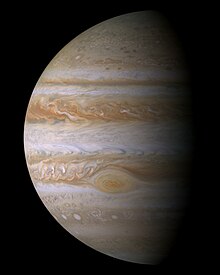
Cassinimade its closest approach to Jupiter on December 30, 2000, at 9.7 million kilometers, and made many scientific measurements. About 26,000 images of Jupiter, itsfaint rings,and itsmoonswere taken during the six-month flyby. It produced the most detailed global color portrait of the planet yet (see image at right), in which the smallest visible features are approximately 60 km (37 mi) across.[72]
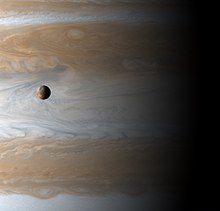
A major finding of the flyby, announced on March 6, 2003, was of Jupiter's atmospheric circulation. Dark "belts" alternate with light "zones" in the atmosphere, and scientists had long considered the zones, with their pale clouds, to be areas of upwelling air, partly because many clouds on Earth form where air is rising. But analysis ofCassiniimagery showed that individual storm cells of upwelling bright-white clouds, too small to see from Earth, pop up almost without exception in the dark belts. According toAnthony Del Genioof NASA'sGoddard Institute for Space Studies,"the belts must be the areas of net-rising atmospheric motion on Jupiter, [so] the net motion in the zones has to be sinking".
Other atmospheric observations included a swirling dark oval of high atmospheric haze, about the size of theGreat Red Spot,near Jupiter's north pole. Infrared imagery revealed aspects of circulation near the poles, with bands of globe-encircling winds, with adjacent bands moving in opposite directions.
The same announcement also discussed the nature of Jupiter'srings.Light scattering by particles in the rings showed the particles were irregularly shaped (rather than spherical) and likely originate as ejecta frommicrometeoriteimpacts on Jupiter's moons, probablyMetisandAdrastea.
Tests of general relativity[edit]
On October 10, 2003, the mission's science team announced the results of tests ofAlbert Einstein'sgeneral theory of relativity,performed by usingradio wavestransmitted from theCassinispace probe.[73]The radio scientists measured afrequencyshift in the radio waves to and from the spacecraft, as they passed close to the Sun. According to the general theory of relativity, a massive object like theSuncausesspace-timeto curve, causing a beam of radiowaves travelling out of itsgravitational wellto decrease infrequencyand radiowaves travelling into the gravitational well to increase in frequency, referred to asgravitational redshift/ blueshift.
Although some measurable deviations from the values calculated using thegeneral theory of relativityare predicted by some unusual cosmological models, no such deviations were found by this experiment. Previous tests using radiowaves transmitted by theVikingandVoyagerspace probes were in agreement with the calculated values from general relativity to within an accuracy of one part in one thousand. The more refined measurements from theCassinispace probe experiment improved this accuracy to about one part in 51,000.[74]The data firmly support Einstein's general theory of relativity.[75]
New moons of Saturn[edit]
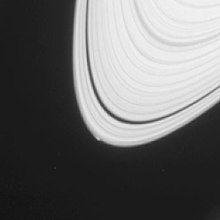
In total, theCassinimission discovered seven new moons orbiting Saturn.[76]Using images taken byCassini,researchers discoveredMethone,PalleneandPolydeucesin 2004,[77]althoughlater analysisrevealed thatVoyager 2had photographed Pallene in its 1981 flyby of the ringed planet.[78]
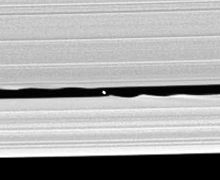
On May 1, 2005, a new moon was discovered byCassiniin theKeeler gap.It was given the designation S/2005 S 1 before being namedDaphnis.A fifth new moon was discovered byCassinion May 30, 2007, and was provisionally labeled S/2007 S 4. It is now known asAnthe.A press release on February 3, 2009, showed a sixth new moon found byCassini.The moon is approximately 500 m (0.3 mi) in diameter within the G-ring of the ring system of Saturn, and is now namedAegaeon(formerly S/2008 S 1).[79]A press release on November 2, 2009, mentions the seventh new moon found byCassinion July 26, 2009. It is presently labeledS/2009 S 1and is approximately 300 m (980 ft) in diameter in the B-ring system.[80]
On April 14, 2014, NASA scientists reported the possible beginning of a new moon in Saturn'sA Ring.[81]
Phoebe flyby[edit]

On June 11, 2004,Cassiniflew by the moonPhoebe.This was the first opportunity for close-up studies of this moon (Voyager 2performed a distant flyby in 1981 but returned no detailed images). It also wasCassini'sonly possible flyby for Phoebe due to the mechanics of the available orbits around Saturn.[82]
The first close-up images were received on June 12, 2004, and mission scientists immediately realized that the surface of Phoebe looks different from asteroids visited by spacecraft. Parts of the heavily cratered surface look very bright in those pictures, and it is currently believed that a large amount of water ice exists under its immediate surface.
Saturn rotation[edit]
In an announcement on June 28, 2004,Cassiniprogram scientists described the measurement of the rotational period of Saturn.[83]Because there are no fixed features on the surface that can be used to obtain this period, the repetition of radio emissions was used. This new data agreed with the latest values measured from Earth, and constituted a puzzle to the scientists. It turns out that the radio rotational period had changed since it was first measured in 1980 byVoyager 1,and it was now 6 minutes longer. This, however, does not indicate a change in the overall spin of the planet. It is thought to be due to variations in the upper atmosphere and ionosphere at the latitudes which are magnetically connected to the radio source region.[84]
In 2019 NASA announced Saturn's rotational period as 10 hours, 33 minutes, 38 seconds, calculated using Saturnian ring seismology. Vibrations from Saturn's interior cause oscillations in its gravitational field. This energy is absorbed by ring particles in specific locations, where it accumulates until it is released in a wave.[85]Scientists used data from more than 20 of these waves to construct a family of models of Saturn's interior, providing basis for calculating its rotational period.[86]
Orbiting Saturn[edit]
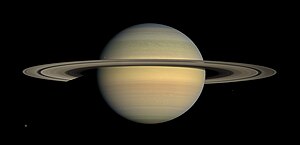
On July 1, 2004, the spacecraft flew through the gap between theF and G ringsand achievedorbit,after a seven-year voyage.[87]It was the first spacecraft to orbit Saturn.
The Saturn Orbital Insertion (SOI) maneuver performed byCassiniwas complex, requiring the craft to orient its High-Gain Antenna away from Earth and along its flight path, to shield its instruments from particles in Saturn's rings. Once the craft crossed the ring plane, it had to rotate again to point its engine along its flight path, and then the engine fired to decelerate the craft by 622 m/s to allow Saturn to capture it.[88]Cassiniwas captured by Saturn's gravity at around 8:54 pmPacific Daylight Timeon June 30, 2004. During the maneuverCassinipassed within 20,000 km (12,000 mi) of Saturn's cloud tops.
When Cassini was in Saturnian orbit, departure from the Saturn system was evaluated in 2008 during end of mission planning.[89][clarification needed]
Titan flybys[edit]
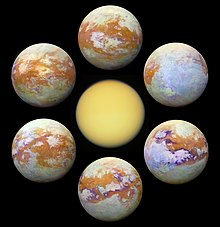
Cassinihad its first flyby ofSaturn'slargest moon,Titan,on July 2, 2004, a day after orbit insertion, when it approached to within 339,000 km (211,000 mi) of Titan. Images taken through special filters (able to see through the moon's global haze) showed south polar clouds thought to be composed ofmethaneand surface features with widely differing brightness. On October 27, 2004, the spacecraft executed the first of the 45 planned close flybys of Titan when it passed a mere 1,200 km (750 mi) above the moon. Almost fourgigabitsof data were collected and transmitted to Earth, including the first radar images of the moon's haze-enshrouded surface. It revealed the surface of Titan (at least the area covered by radar) to be relatively level, with topography reaching no more than about 50 m (160 ft) in altitude. The flyby provided a remarkable increase in imaging resolution over previous coverage. Images with up to 100 times better resolution were taken and are typical of resolutions planned for subsequent Titan flybys. Cassini collected pictures of Titan and the lakes of methane were similar to the lakes of water on Earth.
Huygenslands on Titan[edit]
| External image | |
|---|---|
ESA/NASA/JPL/University of Arizona(ESA hosting) |
Cassinireleased theHuygensprobe on December 25, 2004, by means of a spring and spiral rails intended to rotate the probe for greater stability. It entered the atmosphere of Titan on January 14, 2005, and after a two-and-a-half-hour descent landed on solid ground.[6]AlthoughCassinisuccessfully relayed 350 of the pictures that it received fromHuygensof its descent and landing site, a malfunction in one of the communications channels resulted in the loss of a further 350 pictures.[90]
Enceladus flybys[edit]
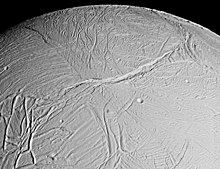
During the first two close flybys of the moonEnceladusin 2005,Cassinidiscovered a deflection in the local magnetic field that is characteristic for the existence of a thin but significant atmosphere. Other measurements obtained at that time point to ionized water vapor as its main constituent.Cassinialso observed water ice geysers erupting from the south pole of Enceladus, which gives more credibility to the idea that Enceladus is supplying the particles of Saturn's E ring. Mission scientists began to suspect that there may be pockets of liquid water near the surface of the moon that fuel the eruptions.[91]
On March 12, 2008,Cassinimade a close fly-by of Enceladus, passing within 50 km of the moon's surface.[92]The spacecraft passed through the plumes extending from its southern geysers, detecting water, carbon dioxide and various hydrocarbons with its mass spectrometer, while also mapping surface features that are at much higher temperature than their surroundings with the infrared spectrometer.[93]Cassiniwas unable to collect data with its cosmic dust analyzer due to an unknown software malfunction.
On November 21, 2009,Cassinimade its eighth flyby of Enceladus,[94]this time with a different geometry, approaching within 1,600 km (990 mi) of the surface. The Composite Infrared Spectrograph (CIRS) instrument produced a map of thermal emissions from theBaghdad Sulcus 'tiger stripe'.The data returned helped create a detailed and high resolution mosaic image of the southern part of the moon's Saturn-facing hemisphere.
On April 3, 2014, nearly ten years afterCassinientered Saturn's orbit, NASA reported evidence of a large salty internal ocean of liquid water in Enceladus. The presence of an internal salty ocean in contact with the moon's rocky core, places Enceladus "among the most likely places in the Solar System to hostalien microbial life".[95][96][97]On June 30, 2014, NASA celebrated ten years ofCassiniexploring Saturn andits moons,highlighting the discovery of water activity on Enceladus among other findings.[98]
In September 2015, NASA announced that gravitational and imaging data fromCassiniwere used to analyze thelibrationsof Enceladus' orbit and determined that the moon's surface is not rigidly joined to its core, concluding that the underground ocean must therefore be global in extent.[99]
On October 28, 2015,Cassiniperformed a close flyby of Enceladus, coming within 49 km (30 mi) of the surface, and passing through theicy plume above the south pole.[100]
On December 14, 2023, astronomers reported the first time discovery, in theplumesof Enceladus, ofhydrogen cyanide,a possible chemical essential forlifeas we know it, as well as otherorganic molecules,some of which are yet to be better identified and understood. According to the researchers, "these [newly discovered] compounds could potentially support extantmicrobial communitiesor drive complexorganic synthesisleading to theorigin of life".[101][102]
Radio occultations of Saturn's rings[edit]
In May 2005,Cassinibegan a series ofradio occultationexperiments, to measure the size-distribution of particles inSaturn's rings,and measure the atmosphere of Saturn itself. For over four months, the craft completed orbits designed for this purpose. During these experiments, it flew behind the ring plane of Saturn, as seen from Earth, and transmitted radio waves through the particles. The radio signals received on Earth were analyzed, for frequency, phase, and power shift of the signal to determine the structure of the rings.
Spokes in rings verified[edit]
In images captured September 5, 2005,Cassinidetected spokes in Saturn's rings,[103]previously seen only by the visual observer Stephen James O'Meara in 1977 and then confirmed by theVoyagerspace probes in the early 1980s.[104][105]
Lakes of Titan[edit]
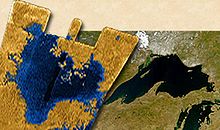

Radar images obtained on July 21, 2006, appear to show lakes ofliquid hydrocarbon(such asmethaneandethane) in Titan's northern latitudes. This is the first discovery of currently existing lakes anywhere besides on Earth. The lakes range in size from one to one-hundred kilometers across.[106]
On March 13, 2007, theJet Propulsion Laboratoryannounced that it had found strong evidence of seas of methane and ethane in the northern hemisphere of Titan. At least one of these is larger than any of theGreat Lakesin North America.[107]
Saturn hurricane[edit]
In November 2006, scientists discovered a storm at the south pole of Saturn with a distincteyewall.This is characteristic of ahurricaneon Earth and had never been seen on another planet before. Unlike aterrestrialhurricane, the storm appears to be stationary at the pole. The storm is 8,000 km (5,000 mi) across, and 70 km (43 mi) high, with winds blowing at 560 km/h (350 mph).[108]
Iapetus flyby[edit]


On September 10, 2007,Cassinicompleted its flyby of the strange, two-toned, walnut-shaped moon,Iapetus.Images were taken from 1,600 km (1,000 mi) above the surface. As it was sending the images back to Earth, it was hit by acosmic raythat forced it to temporarily entersafe mode.All of the data from the flyby were recovered.[109]
Mission extension[edit]
On April 15, 2008,Cassinireceived funding for a 27-month extended mission. It consisted of 60 more orbits ofSaturn,with 21 more close Titan flybys, seven of Enceladus, six of Mimas, eight of Tethys, and one targeted flyby each ofDione,Rhea,andHelene.[110]The extended mission began on July 1, 2008, and was renamed theCassini Equinox Missionas the mission coincided with Saturn'sequinox.[111]
Second mission extension[edit]
A proposal was submitted to NASA for a second mission extension (September 2010 – May 2017), provisionally named the extended-extended mission or XXM.[112]This ($60M pa) was approved in February 2010 and renamed theCassini Solstice Mission.[113]It includedCassiniorbiting Saturn 155 more times, conducting 54 additional flybys ofTitanand 11 more of Enceladus.
Great Storm of 2010 and aftermath[edit]
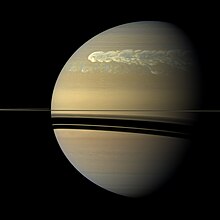
On October 25, 2012,Cassiniwitnessed the aftermath of the massiveGreat White Spotstorm that recurs roughly every 30 years on Saturn.[114]Data from the composite infrared spectrometer (CIRS) instrument indicated a powerful discharge from the storm that caused a temperature spike in the stratosphere of Saturn 83 K (83 °C; 149 °F) above normal. Simultaneously, a huge increase inethylenegas was detected by NASA researchers at Goddard Research Center in Greenbelt, Maryland. Ethylene is a colorless gas that is highly uncommon on Saturn and is produced both naturally and through man-made sources on Earth. The storm that produced this discharge was first observed by the spacecraft on December 5, 2010, in Saturn's northern hemisphere. The storm is the first of its kind to be observed by a spacecraft in orbit around Saturn as well as the first to be observed at thermal infrared wavelengths, allowing scientists to observe the temperature of Saturn's atmosphere and track phenomena that are invisible to the naked eye. The spike of ethylene gas that was produced by the storm reached levels that were 100 times more than those thought possible for Saturn. Scientists have also determined that the storm witnessed was the largest, hottest stratospheric vortex ever detected in the Solar System, initially being larger than Jupiter'sGreat Red Spot.
Venus transit[edit]
On December 21, 2012,Cassiniobserved atransit of Venusacross the Sun.[115]The VIMS instrument analyzed sunlight passing through the Venusian atmosphere.[115]VIMS previously observed the transit of exoplanetHD 189733 b.[115]
The Day the Earth Smiled[edit]

On July 19, 2013, the probe was pointed towards Earth to capture an image of the Earth and theMoon,as part of a natural light, multi-image portrait of the entire Saturn system. The event was unique as it was the first time NASA informed the public that a long-distance photo was being taken in advance.[116][117]The imaging team said they wanted people to smile and wave to the skies, withCassiniscientistCarolyn Porcodescribing the moment as a chance to "celebrate life on thePale Blue Dot".[118]
Rhea flyby[edit]
On February 10, 2015, theCassinispacecraft visitedRheamore closely, coming within 47,000 km (29,000 mi).[119]The spacecraft observed the moon with its cameras producing some of the highest resolution color images yet of Rhea.[120]
Hyperion flyby[edit]
Cassiniperformed its latest flyby of Saturn's moonHyperionon May 31, 2015, at a distance of about 34,000 km (21,000 mi).[121]
Dione flyby[edit]
Cassiniperformed its last flyby of Saturn's moonDioneon August 17, 2015, at a distance of about 475 km (295 mi). A previous flyby was performed on June 16.[122]
Hexagon changes color[edit]
Between 2012 and 2016, the persistent hexagonal cloud pattern at Saturn's north pole changed from a mostly blue color to more of a golden color.[123]One theory for this is a seasonal change: extended exposure to sunlight may be creating haze as the pole swivels toward the Sun.[123]It was previously noted that there was less blue color overall on Saturn between 2004 and 2008.[124]
-
2012 and 2016: hexagon color changes
-
2013 and 2017: hexagon color changes
Grand Finale and destruction[edit]
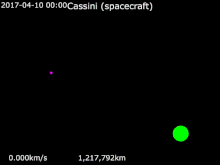
- Cassini
- Saturn
Cassini'send involved a series of close Saturn passes, approaching within therings,then an entry into Saturn's atmosphere on September 15, 2017, to destroy the spacecraft.[6][11][89]This method was chosen because it is imperative to ensureprotectionand prevent biological contamination to any of the moons of Saturn thought to offer potentialhabitability.[125]
In 2008 a number of options were evaluated to achieve this goal, each with varying funding, scientific, and technical challenges. A short period Saturn impact for an end of mission was rated "excellent" with the reasons "D-ring option satisfies unachieved AO goals;[definition needed]cheap and easily achievable "while collision with an icy moon was rated" good "for being" cheap and achievable anywhere/time ".[citation needed]
There were problems in 2013–14 about NASA receiving U.S. government funding for the Grand Finale. The two phases of the Grand Finale ended up being the equivalent of having two separateDiscovery Program-classmissions in that the Grand Finale was completely different from the mainCassiniregular mission. The U.S. government in late 2014 approved the Grand Finale at the cost of $200 million. This was far cheaper than building two new probes in separate Discovery-class missions.[126]
On November 29, 2016, the spacecraft performed a Titan flyby that took it to the gateway of F-ring orbits: This was the start of the Grand Finale phase culminating in its impact with the planet.[127][128]A final Titan flyby on April 22, 2017, changed the orbit again to fly through the gap between Saturn and its inner ring days later on April 26.Cassinipassed about 3,100 km (1,900 mi) above Saturn's cloud layer and 320 km (200 mi) from the visible edge of the inner ring; it successfully took images of Saturn's atmosphere and began returning data the next day.[129]After a further 22 orbits through the gap, the mission was ended with a dive into Saturn's atmosphere on September 15; signal was lost at 11:55:46 UTC on September 15, 2017, just 30 seconds later than predicted. It is estimated that the spacecraft burned up about 45 seconds after the last transmission.
In September 2018, NASA won anEmmy Awardfor Outstanding Original Interactive Program for its presentation of theCassinimission's Grand Finale at Saturn.[130]
In December 2018, Netflix aired "NASA's Cassini Mission" on their series7 Days Outdocumenting the final days of work on theCassinimission before the spacecraft crashed into Saturn to complete its Grand Finale.
In January 2019, new research using data collected duringCassini'sGrand Finale phase was published:
- The final close passes by the rings and planet enabled scientists to measure the length of a day on Saturn: 10 hours, 33 minutes and 38 seconds.
- Saturn's rings are relatively new, 10 to 100 million years old.[131]
Missions[edit]
The spacecraft operation was organized around a series of missions.[133]Each is structured according to a certain amount of funding, goals, etc.[133]At least 260 scientists from 17 countries have worked on theCassini–Huygensmission; in addition thousands of people overall worked to design, manufacture, and launch the mission.[134]
- Prime Mission, July 2004 through June 2008.[135][136]
- CassiniEquinox Mission was a two-year mission extension which ran from July 2008 through September 2010.[133]
- CassiniSolstice Mission ran from October 2010 through April 2017.[133][137](Also known as the XXM mission.)[124]
- Grand Finale (spacecraft directed into Saturn), April 2017 to September 15, 2017.[137]
-
Saturn byCassini,2016
-
Cassini-Huygensby the numbers
(September 2017) -
Farewell to Saturn and moons (Enceladus,Epimetheus,Janus,Mimas,PandoraandPrometheus)
(September 13, 2017)
Glossary[edit]
- AACS: Attitude and Articulation Control Subsystem
- ACS: Attitude Control Subsystem
- AFC: AACS Flight Computer
- ARWM: Articulated Reaction Wheel Mechanism
- ASI: Agenzia Spaziale Italiana, the Italian space agency
- BIU: Bus Interface Unit
- BOL: Beginning of Life
- CAM: Command Approval Meeting
- CDS: Command and Data Subsystem—Cassini computer that commands and collects data from the instruments
- CICLOPS:Cassini Imaging Central Laboratory for OperationsArchivedMay 1, 2008, at theWayback Machine
- CIMS:CassiniInformation Management System
- CIRS: Composite Infrared Spectrometer
- DCSS: Descent Control Subsystem
- DSCC: Deep Space Communications Center
- DSN: Deep Space Network (large antennas around the Earth)
- DTSTART: Dead Time Start
- ELS: Electron Spectrometer (part of CAPS instrument)
- EOM: End of Mission
- ERT: Earth-received time, UTC of an event
- ESA: European Space Agency
- ESOC: European Space Operations Centre
- FSW: flight software
- HGA:High Gain Antenna
- HMCS:HuygensMonitoring and Control System
- HPOC:HuygensProbe Operations Center
- IBS: Ion Beam Spectrometer (part of CAPS instrument)
- IEB: Instrument Expanded Blocks (instrument command sequences)
- IMS: Ion Mass Spectrometer (part of CAPS instrument)
- ITL: Integrated Test Laboratory—spacecraft simulator
- IVP: Inertial Vector Propagator
- LGA:Low Gain Antenna
- NAC: Narrow Angle Camera
- NASA: National Aeronautics and Space Administration, the United States space agency
- OTM: Orbit Trim Maneuver
- PDRS: Probe Data Relay Subsystem
- PHSS: Probe Harness SubSystem
- POSW: Probe On-Board Software
- PPS: Power and Pyrotechnic Subsystem
- PRA: Probe Relay Antenna
- PSA: Probe Support Avionics
- PSIV: Preliminary Sequence Integration and Validation
- PSE: probe support equipment
- RCS: Reaction Control System
- RFS: Radio Frequency Subsystem
- RPX: ring plane crossing
- RWA: Reaction Wheel Assembly
- SCET: Spacecraft Event Time
- SCR: sequence change requests
- SKR: Saturn Kilometric Radiation
- SOI: Saturn Orbit Insertion (July 1, 2004)
- SOP: Science Operations Plan
- SSPS: Solid State Power Switch
- SSR: Solid State Recorder
- SSUP: Science and Sequence Update Process
- TLA: Thermal Louver Assemblies
- USO: UltraStable Oscillator
- VRHU: Variable Radioisotope Heater Units
- WAC: Wide Angle Camera
- XXM: Extended-Extended Mission
See also[edit]
- Europlanet,data network
- Galileo,Jupiter orbiter and entry probe (1989–2003)
- In Saturn's Rings
- List of missions to the outer planets
- Planetary Science Decadal Survey
- Timeline ofCassini–Huygens
References[edit]
- ^"HUYGENS".
- ^abcd"Cassini–Huygens: Quick Facts".NASA.RetrievedAugust 20,2011.
- ^Krebs, Gunter Dirk."Cassini / Huygens".Gunter's Space Page.RetrievedJune 15,2016.
- ^Barber, Todd J. (August 23, 2010)."Insider's Cassini: Power, Propulsion, and Andrew Ging".NASA. Archived fromthe originalon April 2, 2012.RetrievedAugust 20,2011.
- ^abBrown, Dwayne; Cantillo, Laurie; Dyches, Preston (September 15, 2017)."NASA's Cassini Spacecraft Ends Its Historic Exploration of Saturn".NASA.RetrievedSeptember 15,2017.
- ^abcd Chang, Kenneth (September 14, 2017)."Cassini Vanishes Into Saturn, Its Mission Celebrated and Mourned".The New York Times.RetrievedSeptember 15,2017.
- ^"Cassini Post-End of Mission News Conference" (Interview). Pasadena, CA: NASA Television. September 15, 2017.
- ^abc"Outer Planets Flagship - Science Mission Directorate".NASA. Archived fromthe originalon May 13, 2017.RetrievedJuly 12,2017.
- ^Corum, Jonathan (December 18, 2015)."Mapping Saturn's Moons".The New York Times.RetrievedDecember 18,2015.
- ^"Saturn Plunge Nears for Cassini Spacecraft".NASA - National Aeronautics and Space Administration.August 29, 2017. Archived fromthe originalon April 30, 2019.RetrievedAugust 30,2017.
- ^abOverbye, Dennis(September 8, 2017)."Cassini Flies Toward a Fiery Death on Saturn".The New York Times.RetrievedSeptember 10,2017.
- ^Mosher, Dave (April 5, 2017)."NASA will destroy a $3.26 billion Saturn probe this summer to protect an alien water world".Business Insider.RetrievedMay 2,2017.
- ^Chang, Kenneth (May 3, 2017)."The 'Sounds' of Space as NASA's Cassini Dives by Saturn".The New York Times.RetrievedMay 3,2017.
- ^"Cassini's First Dive Between Saturn and its Rings".Jet Propulsion Laboratory.
- ^ab"Overview | Cassini".NASA Solar System Exploration.RetrievedAugust 22,2022.
- ^"ESA Science & Technology - Cassini Equinox Mission".sci.esa.int.RetrievedAugust 22,2022.
- ^"ESA Science & Technology - Huygens Probe Separation and Coast Phase".sci.esa.int.RetrievedAugust 22,2022.
- ^abc"'Our Saturn years' - Cassini-Huygens' epic journey to the ringed planet, told by the people who made it happen ".BBC News.RetrievedSeptember 14,2017.
- ^"Overview | Cassini".NASA.Archivedfrom the original on September 26, 2018.RetrievedApril 14,2021.
- ^"Cassini-Huygens".Agenzia Spaziale Italiana. December 2008. Archived fromthe originalon September 21, 2017.RetrievedApril 16,2017.
- ^Miller, Edward A.; Klein, Gail; Juergens, David W.; Mehaffey, Kenneth; Oseas, Jeffrey M.; et al. (October 1996)."The Visual and Infrared Mapping Spectrometer for Cassini"(PDF).In Horn, Linda (ed.).Cassini/Huygens: A Mission to the Saturnian Systems.Vol. 2803. pp. 206–220.Bibcode:1996SPIE.2803..206M.doi:10.1117/12.253421.S2CID34965357.Archived fromthe original(PDF)on August 9, 2017.RetrievedAugust 14,2017.
- ^Reininger, Francis M.; Dami, Michele; Paolinetti, Riccardo; Pieri, Silvano; Falugiani, Silvio; et al. (June 1994). "Visible Infrared Mapping Spectrometer--visible channel (VIMS-V)". In Crawford, David L.; Craine, Eric R. (eds.).Instrumentation in Astronomy VIII.Vol. 2198. pp. 239–250.Bibcode:1994SPIE.2198..239R.doi:10.1117/12.176753.S2CID128716661.
- ^ab Brown, Dwayne; Martinez, Carolina (April 15, 2008)."NASA Extends Cassini's Grand Tour of Saturn".NASA / Jet Propulsion Laboratory.RetrievedAugust 14,2017.
- ^"Mariner Mark II (Cassini)".The Planetary Society.Archivedfrom the original on October 24, 2020.RetrievedApril 14,2021.
- ^"Cassini-Huygens mission objectives".March 27, 2012.
- ^"Mission Summary".sci.esa.int.RetrievedFebruary 3,2017.
- ^"Cassini Solstice Mission-FAQs".Jet Propulsion Laboratory.RetrievedJanuary 24,2014.
- ^"NASA Extends Cassini Probe's Mission at Saturn".Space. April 15, 2008.RetrievedSeptember 1,2010.
- ^Moskowitz, Clara (February 3, 2010)."Cassini Saturn Probe Gets 7-Year Life Extension".Space.RetrievedAugust 20,2011.
- ^Ride, Sally K.(August 1987).Leadership and America's Future in Space(Report). NASA. p. 27. NASA-TM-89638; N87-30248.Archived(PDF)from the original on May 1, 2018.
- ^Ip, Wing; Gautier, Daniel; Owen, Tobias (April 16, 2004).The genesis of Cassini-Huygens.Titan - from Discovery to Encounter: International Conference on the occasion of the 375th birthday of Christiaan Huygens. April 13–17, 2004. ESTEC, Noordwijk, the Netherlands. p. 218.Bibcode:2004ESASP1278..211I.
- ^Rensberger, Royce (November 28, 1988)."EUROPEANS ENDORSE JOINT SPACE MISSION".RetrievedSeptember 15,2017.
- ^Morgan, Dan (October 18, 1989)."BIG INCREASES APPROVED FOR HOUSING, VETS' CARE".RetrievedSeptember 15,2017.
- ^William J. Broad (September 8, 1997)."Saturn Mission's Use of Plutonium Fuel Provokes Warnings of Danger".The New York Times.RetrievedSeptember 1,2010.
- ^"Dozens arrested in protest of plutonium-fueled space mission".CNN. October 4, 1997.RetrievedSeptember 1,2010.
- ^Christopher Boyd (October 5, 1997)."27 Arrested at Protest of Cassini".Orlando Sentinel.RetrievedSeptember 1,2010.
- ^"Cassini Spacecraft Nears Liftoff, but Critics Object to its Risks".The New York Times.October 12, 1997.RetrievedSeptember 1,2010.
- ^Daniel Sorid (August 18, 1999)."Activists Stand their Ground, Even As Cassini Sails Safely Away".Space.RetrievedSeptember 1,2010.
- ^"Cassini spacecraft".European Space Agency.RetrievedApril 5,2018.
- ^"Cassini Spacecraft and Huygens Probe"(PDF).NASA/Jet Propulsion Laboratory. May 1999. JPL 400-777. Archived fromthe original(PDF)on December 24, 2016.RetrievedApril 5,2018.
- ^Coustenis, Athena; Taylor, Fredric W. (2008).Titan: Exploring an Earthlike World.Series on Atmospheric, Oceanic and Planetary Physics. Vol. 4 (2nd ed.). World Scientific. p. 75.ISBN978-981-270-501-3.
- ^Barber, Todd J. (July 9, 2018).Final Cassini Propulsion System In-Flight Characterization.54th AIAA/SAE/ASEE Joint Propulsion Conference.doi:10.2514/6.2018-4546.RetrievedJuly 1,2024.
- ^abGrandidier J.; Gilbert J. B.; Carr G. A. (2017)."Cassini Power Subsystem"(PDF).Jet Propulsion Laboratory.
- ^"Signatures from Earth Board Spacecraft to Saturn".Cassini: The Grand Finale.RetrievedOctober 10,2017.
- ^"616,400 Signatures".Cassini: The Grand Finale.RetrievedOctober 10,2017.
- ^Overbye, Dennis(August 6, 2014)."Storm Chasing on Saturn".The New York Times.RetrievedAugust 6,2014.
- ^ab"Cassini: Mission to Saturn: Cassini Orbiter".
- ^abcdefghijkl"Cassini Orbiter Instruments".Saturn.jpl.nasa.gov.RetrievedAugust 20,2011.
- ^"CAPS team page".Caps.space.swri.edu. Archived fromthe originalon October 8, 2018.RetrievedAugust 20,2011.
- ^"Cassini Significant Events newsletter 2012 03 26".JPL.Archived fromthe originalon September 12, 2015.RetrievedDecember 13,2018.
- ^Altobelli, N.; Postberg, F.; Fiege, K.; Trieloff, M.; Kimura, H.; Sterken, V. J.; Hsu, H.- W.; Hillier, J.; Khawaja, N.; Moragas-Klostermeyer, G.; Blum, J.; Burton, M.; Srama, R.; Kempf, S.; Gruen, E. (2016). "Flux and composition of interstellar dust at Saturn from Cassini's Cosmic Dust Analyzer".Science.352(6283): 312–318.Bibcode:2016Sci...352..312A.doi:10.1126/science.aac6397.PMID27081064.S2CID24111692.
- ^Waite J. H.; Lewis S.; Kasprzak W. T.; Anicich V. G.; Block B. P.; Cravens T. E.; Fletcher G. G.; Ip W. H.; Luhmann J. G.; McNutt R. L.; Niemann H. B.; Parejko J. K.; Richards J. E.; Thorpe R. L.; Walter E. M.; Yelle R. V. (2004)."The Cassini ion and neutral mass spectrometer (INMS) investigation"(PDF).Space Science Reviews.114(1–4): 113–231.Bibcode:2004SSRv..114..113W.doi:10.1007/s11214-004-1408-2.hdl:2027.42/43764.S2CID120116482.
- ^"INMS team page".Inms.space.swri.edu. Archived fromthe originalon August 18, 2011.RetrievedAugust 20,2011.
- ^Porco C. C.; West R. A.; Squyres S.; McEwen A.; Thomas P.;Murray Carl D.;Delgenio A.; Ingersoll A. P.; Johnson T. V.; Neukum G.; Veverka J.; Dones L.; Brahic A.; Burns J. A.; Haemmerle V.; Knowles B.; Dawson D.; Roatsch T.; Beurle K.; Owen W. (2004). "Cassini Imaging Science: Instrument characteristics and anticipated scientific investigations at Saturn".Space Science Reviews.115(1–4): 363–497.Bibcode:2004SSRv..115..363P.doi:10.1007/s11214-004-1456-7.S2CID122119953.
- ^Dougherty M. K.; Kellock S.; Southwood D. J.; Balogh A.; Smith E. J.; Tsurutani B. T.; Gerlach B.; Glassmeier K. H.; Gleim F.; Russell C. T.; Erdos G.; Neubauer E. M.; Cowley S. W. H. (2004)."The Cassini magnetic field investigation"(PDF).Space Science Reviews.114(1–4): 331–383.Bibcode:2004SSRv..114..331D.CiteSeerX10.1.1.454.6826.doi:10.1007/s11214-004-1432-2.S2CID3035894.Archived fromthe original(PDF)on August 10, 2017.RetrievedNovember 1,2017.
- ^"Mimi Inca".Sd- jhuapl.edu.RetrievedAugust 20,2011.
- ^Krimigis S. M.; Mitchell D. G.; Hamilton D. C.; Livi S.; Dandouras J.; Jaskulek S.; Armstrong T. P.; Boldt J. D.; Cheng A. F.; Gloeckler G.; Hayes J. R.;Hsieh K. C.;Ip W. H.; Keath E. P.; Kirsch E.; Krupp N.; Lanzerotti L. J.; Lundgren R.; Mauk B. H.; McEntire R. W.; Roelof E. C.; Schlemm C. E.; Tossman B. E.; Wilken B.; Williams D. J. (2004). "Magnetosphere imaging instrument (MIMI) on the Cassini mission to Saturn/Titan".Space Science Reviews.114(1–4): 233–329.Bibcode:2004SSRv..114..233K.doi:10.1007/s11214-004-1410-8.S2CID108288660.
- ^The Cassini Ultraviolet Imaging Spectrograph Investigation
- ^Cassini UVIS Stellar Occultation Observation of Saturn's Rings
- ^Enceladus' Water Vapor Plume
- ^abcde"Why the Cassini Mission Cannot Use Solar Arrays"(PDF).NASA/JPL. December 6, 1996. Archived fromthe original(PDF)on February 26, 2015.RetrievedMarch 21,2014.
- ^Bennett, G. L; Lombardo, J. J; Hemler, Richard J; Silverman, Gil; Whitmore, C. W; Amos, Wayne R; Johnson, E. W; Schock, Alfred; Zocher, Roy W; Keenan, Thomas K; Hagan, James C; Englehart, Richard W (June 26–29, 2006)."Mission of Daring: The General-Purpose Heat Source Radioisotope Thermoelectric Generator AIAA 2006-4096, 4th International Energy Conversion Engineering Conference and Exhibit (IECEC)"(PDF).San Diego, California. p. 4.RetrievedAugust 30,2022.
- ^Meltzer, Michael (2015).The Cassini-Huygens Visit to Saturn: An Historic Mission to the Ringed Planet.Springer.p. 70.ISBN9783319076089.
- ^"Cassini–Huygens:Quick Facts".Saturn.jpl.nasa.gov.RetrievedJuly 1,2014.
- ^ab"CassiniFinal Environmental Impact Statement ".Archived fromthe originalon June 8, 2011.,see"Chapter 2"(PDF).Archived fromthe original(PDF)on January 19, 2012.,Table 2-8
- ^Friedensen, Victoria Pidgeon (1999)."Chapter 3".Protest Space: A Study of Technology Choice, Perception of Risk, and Space Exploration(Master of Science thesis).hdl:10919/36022.Archived(PDF)from the original on March 6, 2002.RetrievedFebruary 28,2011.
- ^Kaku, Michio (October 5, 1997)."A Scientific Critique of the Accident Risks from the Cassini Space Mission".The Animated Software Company.Archivedfrom the original on July 9, 2021.RetrievedJanuary 15,2021.
- ^Kan, Edwin P. (November 1994).Process and Methodology of Developing Cassini G&C Telemetry Dictionary(PDF).Third International Symposium on Space Mission Operations and Ground Data Systems. Greenbelt. Archived fromthe original(PDF)on May 10, 2013.
- ^How to Land on TitanArchivedJuly 21, 2011, at theWayback Machine,Ingenia,June 2005
- ^How Huygens avoided disaster,James Oberg,The Space Review,January 17, 2005.
- ^"New Cassini Images of Asteroid Available"(Press release). JPL. February 11, 2000. Archived fromthe originalon June 12, 2010.RetrievedOctober 15,2010.
- ^Hansen, C. J.; Bolton, S. J.; Matson, D. L.; Spilker, L. J.; Lebreton, J. P. (2004). "The Cassini–Huygens flyby of Jupiter".Icarus.172(1): 1–8.Bibcode:2004Icar..172....1H.doi:10.1016/j.icarus.2004.06.018.
- ^Bertotti, B.; Iess, L.; Tortora, P. (2003). "A test of general relativity using radio links with the Cassini spacecraft".Nature.425(6956): 374–376.Bibcode:2003Natur.425..374B.doi:10.1038/nature01997.PMID14508481.S2CID4337125.
- ^This is currently the best measurement ofpost-Newtonian parameterγ;the resultγ= 1 + (2.1 ± 2.3) × 10−5agrees with the prediction of standard General Relativity,γ= 1
- ^Dumé, Isabelle (September 24, 2003)."General relativity passes Cassini test".Physics World.
- ^Meltzer 2015, pp. 346–351
- ^"Newest Saturn moons given names".BBC News.February 28, 2005.RetrievedSeptember 1,2016.
- ^Spitale, J. N.; Jacobson, R. A.; Porco, C. C.; Owen, W. M. Jr. (2006)."The orbits of Saturn's small satellites derived from combined historic andCassiniimaging observations ".The Astronomical Journal.132(2): 692–710.Bibcode:2006AJ....132..692S.doi:10.1086/505206.
- ^"Surprise! Saturn has small moon hidden in ring".NBC News.March 3, 2009. Archived fromthe originalon December 17, 2013.RetrievedAugust 29,2015.
- ^Green, Daniel W. E. (November 2, 2009)."IAU Circular No. 9091".CICLOPS. Archived fromthe originalon June 11, 2011.RetrievedAugust 20,2011.
- ^Platt, Jane; Brown, Dwayne (April 14, 2014)."NASA Cassini Images May Reveal Birth of a Saturn Moon".NASA.RetrievedApril 14,2014.
- ^Porco, C. C.; Baker, E.; Barbara, J.; Beurle, K.; Brahic, A.; Burns, J. A.; Charnoz, S.; Cooper, N.; Dawson D., D.; Del Genio, A. D.; Denk, T.; Dones, L.; Dyudina, U.; Evans, M. W.; Giese, B.; Grazier, K.; Heifenstein, P.; Ingersoll, A. P.; Jacobson, R. A.; Johnson, T. V.; McEwen, A.; Murray, C. D.; Neukum, G.; Owen, W. M.; Perry, J.; Roatsch, T.; Spitale, J.; Squyres, S.; Thomas, P. C.; Tiscareno, M.; Turtle, E.; Vasavada, A. R.; Veverka, J.; Wagner, R.; West, R. (2005)."Cassini Imaging Science: Initial results on Phoebe and Iapetus"(PDF).Science.307(5713): 1237–1242.Bibcode:2005Sci...307.1237P.doi:10.1126/science.1107981.PMID15731440.S2CID20749556.
- ^Carolina Martinez; Gary Galluzzo (June 28, 2004)."Scientists Find That Saturn's Rotation Period is a Puzzle".JPL. Archived fromthe originalon June 5, 2011.RetrievedAugust 20,2011.
- ^Chowdhury, Nahid (2022)."Saturn's Weather-Driven Aurorae Modulate Oscillations in the Magnetic Field and Radio Emissions".Geophysical Research Letters.49(e2021GL096492).Bibcode:2022GeoRL..4996492C.doi:10.1029/2021GL096492.
- ^"Scientists Finally Know What Time It Is On Saturn".JPL. 2019.RetrievedJune 22,2020.
- ^Mankovich, Christopher; Marley, Mark S.; Fortney, Jonathan J.; Movshovitz, Naor (2018)."Cassini Ring Seismology as a Probe of Saturn's Interior I: Rigid Rotation".The Astrophysical Journal.871(1): 1.arXiv:1805.10286.Bibcode:2019ApJ...871....1M.doi:10.3847/1538-4357/aaf798.S2CID67840660.
- ^Porco, Carolyn C. (2007). "Cassini, the first one thousand days".American Scientist.95(4): 334–341.doi:10.1511/2007.66.334.
- ^"Cassini/Huygens: Heavily Instrumented Flight Systems Approaching Saturn and Titan"(PDF).Archived fromthe original(PDF)on August 7, 2011.RetrievedAugust 20,2011.
- ^abSpilker, Linda."Cassini Extended Missions"(PDF).RetrievedAugust 20,2011.
- ^"Huygens Probe Returns First Images of Titan's Surface".Space.January 14, 2005.RetrievedJanuary 9,2015.
- ^Cook, Jia-Rui; Brown, Dyawne C. (July 6, 2011)."Cassini Spacecraft Captures Images and Sounds of Big Saturn Storm".JPL. Archived fromthe originalon March 3, 2008.RetrievedAugust 20,2011.
- ^"CassiniSpacecraft to Dive Into Water Plume of Saturn Moon ".ArchivedNovember 9, 2020, at theWayback Machine.NASA, March 10, 2008
- ^"CassiniTastes Organic Material at Saturn's Geyser Moon ".ArchivedJuly 20, 2021, at theWayback Machine.NASA, March 26, 2008
- ^"Cassini Sends Back Images of Enceladus as Winter Nears".Archived fromthe originalon March 11, 2016.RetrievedDecember 13,2018.
- ^Amos, Jonathan (April 3, 2014)."Saturn's Enceladus moon hides 'great lake' of water".BBC News.RetrievedApril 7,2014.
- ^Iess, L.; Stevenson, D. J.; Parisi, M.; Hemingway, D.; Jacobson, R. A.; Lunine, Jonathan I.; Nimmo, F.; Armstrong, J. W.; Asmar, S. W.; Ducci, M.; Tortora, P. (April 4, 2014)."The Gravity Field and Interior Structure of Enceladus"(PDF).Science.344(6179): 78–80.Bibcode:2014Sci...344...78I.doi:10.1126/science.1250551.PMID24700854.S2CID28990283.
- ^Sample, Ian (April 3, 2014)."Ocean discovered on Enceladus may be best place to look for alien life".The Guardian.RetrievedApril 3,2014.
- ^Dyches, Preston; Clavin, Whitney (June 25, 2014)."Cassini Celebrates 10 Years Exploring Saturn".NASA.RetrievedJune 25,2014.
- ^"Cassini Finds Global Ocean in Saturn's Moon Enceladus".Jet Propulsion Laboratory.RetrievedSeptember 14,2015.
- ^"Deepest-Ever Dive Through Enceladus Plume Completed".Jet Propulsion Laboratory. October 28, 2015.RetrievedOctober 29,2015.
- ^Chang, Kenneth (December 14, 2023)."Poison Gas Hints at Potential for Life on an Ocean Moon of Saturn".The New York Times.Archivedfrom the original on December 14, 2023.RetrievedDecember 15,2023.
A researcher who has studied the icy world said 'the prospects for the development of life are getting better and better on Enceladus'.
- ^Peter, Jonah S.; et al. (December 14, 2023)."Detection of HCN and diverse redox chemistry in the plume of Enceladus".Nature Astronomy.8(2): 164–173.arXiv:2301.05259.doi:10.1038/s41550-023-02160-0.S2CID255825649.Archivedfrom the original on December 15, 2023.RetrievedDecember 15,2023.
- ^Nemiroff, R.; Bonnell, J., eds. (November 27, 2006)."Mysterious Spokes in Saturn's Rings".Astronomy Picture of the Day.NASA.RetrievedDecember 5,2013.
- ^"Catalog Page for PIA05380: Approach to Saturn".NASA Jet Propulsion Laboratory. February 26, 2004.RetrievedAugust 20,2011.
- ^"The Rings of Saturn".Department of Physics and Astronomy, University of Tennessee in Knoxville. Archived fromthe originalon December 12, 2013.RetrievedDecember 5,2013.
- ^"Cassini Spacecraft Captures Images and Sounds of Big Saturn Storm".JPL. July 6, 2011. Archived fromthe originalon April 30, 2008.RetrievedAugust 20,2011.
- ^"Cassini-Huygens: News".JPL. Archived fromthe originalon May 8, 2008.RetrievedAugust 20,2011.
- ^"Huge 'hurricane' rages on Saturn".BBC News.November 10, 2006.RetrievedNovember 10,2006.
- ^"Cassini Probe Flies by Iapetus, Goes into Safe Mode".Fox News.September 14, 2007. Archived fromthe originalon October 21, 2012.RetrievedSeptember 17,2007.
- ^"Cassini's Tour of the Saturn System".Planetary Society.Archived fromthe originalon April 25, 2009.RetrievedFebruary 26,2009.
- ^"Cassini To Earth: 'Mission Accomplished, But New Questions Await!'".Science Daily.June 29, 2008.RetrievedJanuary 5,2009.
- ^John Spencer (February 24, 2009)."Cassini's proposed extended-extended mission tour".Planetary Society. Archived fromthe originalon June 15, 2010.RetrievedAugust 20,2011.
- ^"NASA Extends Cassini's Tour of Saturn, Continuing International Cooperation for World Class Science".ArchivedApril 13, 2016, at theWayback Machine.NASA / California Institute of Technology / Jet Propulsion Laboratory, February 3, 2010, retrieved January 2, 2011
- ^Brown, Dwayne; Zubritsky, Elizabeth; Neal-Jones, Nancy; Cook, Jia-Rui (October 25, 2012)."NASA Spacecraft Sees Huge Burp At Saturn After Large Storm".NASA.NASA.Archivedfrom the original on October 27, 2012.RetrievedApril 14,2021.
- ^abcCook, Jia-Rui (December 20, 2012)."Cassini Instrument Learns New Tricks".Jet Propulsion Laboratory,NASA.Archivedfrom the original on December 22, 2012.RetrievedApril 14,2021.
- ^abOverbye, Dennis (November 12, 2013)."The View From Saturn".The New York Times.RetrievedNovember 12,2013.
- ^"Cassini probe takes image of Earth from Saturn orbit".BBC News.July 23, 2013.RetrievedJuly 24,2013.
- ^"Smile! Cassini sets up photo of Earth".BBC News.July 19, 2013.RetrievedJuly 24,2013.
- ^"Saturn Tour Dates: 2015".NASA / Jet Propulsion Laboratory. 2015. Archived fromthe originalon May 18, 2015.RetrievedMay 2,2017.
- ^"Return to Rhea (NASA Cassini Saturn Mission Images)".Cassini Imaging Central Laboratory for Operations. March 30, 2015. PIA19057. Archived fromthe originalon June 21, 2017.RetrievedMay 11,2015.
- ^"Cassini Prepares for Last Up-close Look at Hyperion".NASA / Jet Propulsion Laboratory.May 28, 2015.RetrievedMay 29,2015.
- ^"Cassini to Make Last Close Flyby of Saturn Moon Dione".NASA / Jet Propulsion Laboratory.August 13, 2015. Archived fromthe originalon August 15, 2015.RetrievedAugust 20,2015.
- ^ab"Changing Colors in Saturn's North".Jet Propulsion Laboratory.
- ^abSpencer, John (February 24, 2009)."Cassini's Proposed Extended-Extended Mission Tour".The Planetary Society.
- ^Blabber, Phillipa; Verrecchia, Angélique (April 3, 2014)."Cassini-Huygens: Preventing Biological Contamination".Space Safety Magazine.RetrievedAugust 1,2015.
- ^Lakdawalla, Emily (September 3, 2014)."Cassini's awesomeness fully funded through mission's dramatic end in 2017".The Planetary Society.Archivedfrom the original on August 10, 2020.RetrievedApril 14,2021.
- ^"2016 Saturn Tour Highlights".
- ^Lewin, Sarah."Cassini Mission Kicks Off Finale at Saturn".Scientific American.RetrievedNovember 30,2016.
- ^Dyches, Preston; Brown, Dwayne; Cantillo, Laurie (April 27, 2017)."NASA Spacecraft Dives Between Saturn and Its Rings".NASA / Jet Propulsion Laboratory.RetrievedMay 2,2017.
- ^McGregor, Veronica; Brown, Dwight; Wendel, JoAnna (September 10, 2018)."And the Emmy goes to: Cassini's Grand Finale".NASA.RetrievedSeptember 10,2018.
- ^"Overview | Cassini".Solar System Exploration: NASA Science.RetrievedJanuary 25,2019.
- ^Loff, Sarah (September 15, 2017)."Impact Site: Cassini's Final Image".NASA.RetrievedSeptember 17,2017.
- ^abcd"Cassini Equinox Mission".European Space Agency. October 18, 2011.RetrievedApril 15,2017.
- ^"Cassini: Mission to Saturn: The Team".NASA.
- ^"Cassini Tour of Saturn and its Moons".European Space Agency. October 7, 2008.RetrievedApril 15,2017.
- ^"Start of the Cassini Equinox Mission".European Space Agency. June 30, 2008.RetrievedApril 15,2017.
- ^ab"The Grand Finale Toolkit".NASA.RetrievedApril 15,2017.
Further reading[edit]
- Ralph Lorenz (2017).NASA/ESA/ASI Cassini-Huygens: 1997 onwards (Cassini orbiter, Huygens probe and future exploration concepts) (Owners' Workshop Manual).Haynes Manuals, UK.ISBN978-1785211119.
- Karl Grossman(1997).The Wrong Stuff: The Space Program's Nuclear Threat to Our Planet.Common Courage Press.ISBN978-1-56751-125-3.
- David M. Harland (2002).Mission to Saturn: Cassini and the Huygens Probe.Springer-Verlag.ISBN978-1-85233-656-1.
- Ralph Lorenz;Jacqueline Mitton(2002).Lifting Titan's Veil: Exploring the Giant Moon of Saturn.Cambridge University Press.ISBN978-0-521-79348-3.
- Meltzer, Michael (2015).The Cassini-Huygens Visit to Saturn: A Historic Mission to the Ringed Planet.Cham: Springer International Publishing Switzerland.ISBN978-3-319-07608-9.
- Irene Klotz (August 31, 2017)."Cassini's Ringside Seat At Saturn Coming To An End".Aviation Week & Space Technology.An epic journey of discovery at Saturn ends, leaving mysteries for future explorers.
External links[edit]
Official websites
- Cassini-HuygenswebsiteArchivedJanuary 26, 2018, at theWayback Machineby theJet Propulsion Laboratory
- Cassini-HuygenswebsitebyNASA
- Cassini-Huygenswebsiteby theEuropean Space Agency
- Cassini-HuygenswebsiteArchivedMay 13, 2017, at theWayback Machineby NASA's Solar System Exploration division
- Cassini Mission ArchiveScience-Data Repositoryat NASA's Planetary Data System
Media and telecommunications
- CICLOPS.org,Cassiniimaging homepage
- CassiniHall of Fame,image galleries by the Jet Propulsion Laboratory
- "Cassini at Saturn",a YouTube playlist by the Jet Propulsion Laboratory
- "Titan Touchdown",Depiction ofHuygensdescent and landing
- DESCANSO DSN Telecom information
- In Saturn's Rings,film animated from millions of still photographs
- Around Saturn,film animated from more than 200,000 images taken byCassinifrom 2004 to 2012
- WebGL-based 3D rendering ofCassini
- Cassini image albumby Kevin M. Gill
- NASA – Through the Eyes of Cassini
- Cassini–Huygens
- Spacecraft launched in 1997
- Spacecraft decommissioned in 2017
- European Space Agency space probes
- NASA space probes
- Spacecraft launched by Titan rockets
- Lunar flybys
- Space synthetic aperture radar
- Missions to main-belt asteroids
- Missions to Saturn
- Missions to Jupiter
- Jet Propulsion Laboratory
- 1997 in Florida
- Christiaan Huygens
- Orbiters (space probe)
- Space radars
- Giovanni Domenico Cassini
- Extraterrestrial atmosphere entry
- Destroyed space probes
- Nuclear-powered robots




